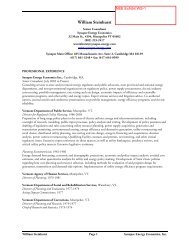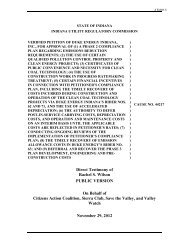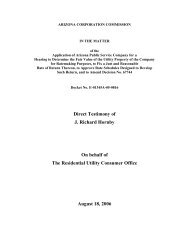Best Practices in Energy Efficiency Program Screening - Synapse ...
Best Practices in Energy Efficiency Program Screening - Synapse ...
Best Practices in Energy Efficiency Program Screening - Synapse ...
You also want an ePaper? Increase the reach of your titles
YUMPU automatically turns print PDFs into web optimized ePapers that Google loves.
<strong>in</strong>dicated <strong>in</strong> Figure A.2, avoided capacity costs start at approximately $7 per MWh <strong>in</strong><br />
2012, and <strong>in</strong>crease to approximately $22 per MWh <strong>in</strong> 2031, with a levelized cost of<br />
about $14 per MWh.<br />
The costs <strong>in</strong> the first few years are based on the FCA floor prices. The costs then<br />
gradually <strong>in</strong>crease as the supply of capacity becomes tighter. F<strong>in</strong>ally, the costs <strong>in</strong>crease<br />
to the capacity costs associated with a peak<strong>in</strong>g unit <strong>in</strong> the years 2024 - 2026 when new<br />
capacity is needed on the system.<br />
(Note that we made some m<strong>in</strong>or modifications to the avoided capacity costs shown <strong>in</strong><br />
Figure A.2 for the years 2016 through 2019. We removed the floor prices <strong>in</strong> the FCM for<br />
these years because they are now outdated and remov<strong>in</strong>g them provides a clearer,<br />
more generally applicable <strong>in</strong>dication of likely changes <strong>in</strong> capacity market prices over<br />
time. Specifically, we <strong>in</strong>creased the 2015 avoided capacity cost by five percent each<br />
year for 2016 through 2019, <strong>in</strong>stead of us<strong>in</strong>g the projected avoided costs for those years.<br />
This modification was not applied <strong>in</strong> the illustrative examples throughout the report; it<br />
was only applied to simplify this chart.)<br />
Avoided Transmission and Distribution Costs<br />
Local transmission and distribution (T&D) <strong>in</strong>frastructure costs are avoided by efficiency<br />
programs due to a reduction <strong>in</strong> the tim<strong>in</strong>g and/or size of new T&D projects that have to<br />
be built, result<strong>in</strong>g from the reduction <strong>in</strong> electric energy that has to be delivered (<strong>Synapse</strong><br />
2011, p.1-4). The basic method <strong>in</strong> most avoided-T&D estimates is to divide actual or<br />
expected <strong>in</strong>vestment by actual or expected load growth.<br />
Not all types of future T&D <strong>in</strong>vestments will be deferrable or avoidable as a result of<br />
reduced load growth from energy efficiency. A significant portion of T&D <strong>in</strong>vestments<br />
might be needed regardless of load growth as a result of deterioration of T&D<br />
equipment, on-go<strong>in</strong>g ma<strong>in</strong>tenance and upgrades, or other factors.<br />
Each utility <strong>in</strong> New England uses utility-specific estimates of avoided T&D, although a<br />
consistent method is utilized by each utility. In New England, avoided transmission<br />
estimates range from $1.25 per kW-year (or $0.26 per MWh) to $20.30 per kW-year (or<br />
$4.21 per MWh). Avoided distribution estimates range from $29.74 per kW-year (or<br />
$6.17 per MWh) to $109.25 per kW-year (or $22.68 per MWh) (<strong>Synapse</strong> 2011, p.6-70).<br />
The methods used by each utility to forecast avoided T&D costs are based on the<br />
relationship between historic T&D costs and historic loads. The future T&D costs <strong>in</strong> New<br />
England, especially transmission costs, are expected to be significantly higher than<br />
those <strong>in</strong> recent years. Therefore, it is quite likely that the forecast of avoided T&D costs<br />
listed above turn out to be significantly lower than the actual avoided T&D costs.<br />
Price Suppression Effects<br />
In regions of the country with organized wholesale energy and capacity markets, energy<br />
efficiency programs can reduce demand, which then can lead to reduced wholesale<br />
energy and capacity prices. Because wholesale energy and capacity markets provide a<br />
s<strong>in</strong>gle clear<strong>in</strong>g price to all wholesale customers purchas<strong>in</strong>g power <strong>in</strong> the relevant time<br />
period, the reductions <strong>in</strong> wholesale energy and capacity clear<strong>in</strong>g prices are experienced<br />
by all customers of those markets. Thus, even a small reduction <strong>in</strong> a market clear<strong>in</strong>g<br />
price can result <strong>in</strong> significant cost reductions across the entire market. This effect is<br />
<strong>Best</strong> <strong>Practices</strong> <strong>in</strong> <strong>Energy</strong> <strong>Efficiency</strong> <strong>Program</strong> Screen<strong>in</strong>g | www.nhpci.org | 71







